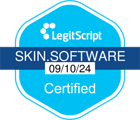While you may not have heard of bemotrizinol, you've likely used it before in sunscreen products.
Bemotrizinol has been a topic of discussion for some time in the scientific community regarding its safety. So, if you're unsure about whether or not you should be avoiding it, allow us to help!
What is bemotrizinol?
Bemotrizinol — also known as bis-ethylhexyloxyphenol methoxyphenyl triazine or 2,2'-(6-(4-Methoxyphenyl)-1,3,5-triazine-2,4-diyl)bis(5-((2-ethylhexyl)oxy)phenol) — is a chemical substance that is found in sunscreen products, as it can absorb both UVA and UVB rays fully [1].
Bemotrizinol is also the most effective UV absorber, as measured by SPF. Because it is photostable, bemotrizinol doesn't degrade and lose effectiveness once it's been exposed to sunlight.
Compared to older broad-spectrum chemical agents, this organic UV filter is also more fat-soluble (meaning it's oil-soluble in cosmetic oils), which aids in its efficacy and broad-spectrum activity.
In addition, Bemotrizinol serves to stop the formation of free radicals that come from UV radiation. Bemotrizinol is commonly marketed as Tinosorb S and Escalol S.
Where is bemotrizinol commonly used?
Bemotrizinol is an active sunscreen agent used in Europe and Australia and will often be paired with less photostable UV blockers such as avobenzone, as the combination creates a much more stable sunscreen, that will not degrade and lose its efficacy when exposed to sunlight [2].
In Australia, we need to wear sunscreen every day due to our high rates of skin cancer, and the fact bemotrizinol can absorb both UVA and UVB rays, providing protection from skin diseases, while also not losing effectiveness is an important consideration to make when purchasing sunscreen.
Software's Daily Sun Defence SPF50+ protects against both UVA and UVB rays, helping to prevent photoageing, sun spots, and some skin cancers. The lightweight formulation blends seamlessly into the skin, sitting nicely under makeup without leaving a white cast.
Is it safe?
While you will find bemotrizinol in sunscreens in Australasia and Europe, it's not used in the USA. The FDA claims to put ingredients, such as those in sunscreen, under a rigorous testing process.
However, scientific data has proven bemotrizinol to be completely safe. Based on the maximum concentration permitted by European legislation, it has been found to be the most effective UV absorber as measured by SPF [3].
Chemicals that are often used in American products for UVA protection have also been found to have flaws, with oxybenzone, an ingredient typically found in sunscreen, being a potential hormone disrupter and may cause allergic reactions. Nevertheless, bemotrizinol has been used safely in Europe, Asia and Australia for over a decade.
Bemotrizinol rarely causes skin irritation and isn't significantly absorbed into the skin, unlike oxybenzone and other sunscreen ingredients. Bemotrizinol is also a great ingredient to have in your sunscreen as it will protect you for longer than other ingredients, which are not as photostable and degrade over time. It also means that it's suitable for water-resistant sunscreen products.
As bemotrizinol is a reasonably new product on the market, few studies document any adverse effects and long-term use. However, the research done to date shows it to have a good safety profile.
The Australian standards are very high regarding product safety, especially concerning products such as sunscreen, which many of us wear every day to reduce our risk of developing skin cancers.
Is it safe for those who are pregnant?
Unlike other sunscreen ingredients, in vitro studies have found that bemotrizinol does not appear to have hormonal effects.
In one study of ultraviolet sunscreen filters Tinosorb M-active and Tinosorb S (bemotrizinol), neither were found to give a positive response when evaluated against in vitro isolated estrogen and androgen receptor competitive binding assays [4].
In addition, both Tinosborb M-active and Tinosorb S were not found to be active in immature rat uterotrophic assay when conducted via injections between the skin and muscles.
The study concluded that neither chemical possessed "intrinsic estrogenic/antiestrogenic or androgenic/antiandrogenic activity".
There are plenty of ingredients in your skincare that you will want to avoid during pregnancy [5]. However, when it comes to sunscreen, the absorption through the skin is generally minimal and will likely not pose a risk to pregnant women and those who choose to breastfeed.
Are there any benefits of bemotrizinol on your skin?
One study has found that bemotrizinol minimises erythema, which is the way the skin reacts to sunburn, friction, exercise and blushing to name a few [6].
It also has excellent anti-ageing effects as it protects the skin's antioxidant defence system — this is because bemotrizinol prevents the formation of free radicals induced by UV rays.
Another study of people undergoing photoprovocation (tests on those with skin disorders provoked by sun exposure) also found that bemotrizinol is helpful in people with polymorphic light eruption (PLE), a rash which is caused by sun exposure in those with a high sensitivity to sunlight [7]. The research found that bemotrizinol was able to prevent the development of PLE.
When it comes to sunscreen ingredients, bemotrizinol is one that is widely used and trusted here in Australia. But, the bottom line is whether your sunscreen is chemical or mineral, the most important thing is that you use it every day to protect your precious skin.
References
- https://pubchem.ncbi.nlm.nih.gov/compound/Bemotrizinol
- https://pubmed.ncbi.nlm.nih.gov/11594052/
- https://www.vinnerlabs.com/comprehensive-study-sunbest-s-tm-bemotrizinol-sunscreen/
- https://pubmed.ncbi.nlm.nih.gov/11754532/
- https://www.seslhd.health.nsw.gov.au/sites/default/files/groups/Royal_Hospital_for_Women/Mothersafe/documents/skinhaircareandcosmetictreatmentsapril2021.pdf
- https://pubchem.ncbi.nlm.nih.gov/compound/Bemotrizinol
- https://pubmed.ncbi.nlm.nih.gov/19002338/
- https://dermnetnz.org/topics/allergy-to-bemotrizinol
- https://www.ulprospector.com/en/asia/PersonalCare/Detail/33308/725741/Bemotrizinol
- Latha MS, Martis J, Shobha V, Sham Shinde R, Bangera S, Krishnankutty B, Bellary S, Varughese S, Rao P, Naveen Kumar BR: Sunscreening agents: a review. J Clin Aesthet Dermatol. 2013 Jan;6(1):16-26. PMID: 23320122
- Schleyer V, Weber O, Yazdi A, Benedix F, Dietz K, Rocken M, Berneburg M: Prevention of polymorphic light eruption with a sunscreen of very high protection level against UVB and UVA radiation under standardized photodiagnostic conditions. Acta Derm Venereol. 2008;88(6):555-60. doi: 10.2340/00015555-0509. PMID: 19002338
- Chatelain E, Gabard B. Photostabilization of butyl methoxydibenzoylmethane (Avobenzone) and ethylhexyl methoxycinnamate by bis-ethylhexyloxyphenol methoxyphenyl triazine (Tinosorb S), a new UV broadband filter. Photochem Photobiol. 2001 Sep;74(3):401-6. doi: 10.1562/0031-8655(2001)074<0401:pobmaa>2.0.co;2. PMID: 11594052.

















.svg)